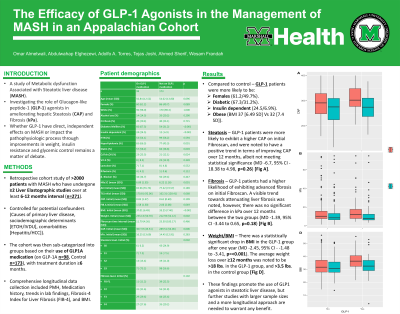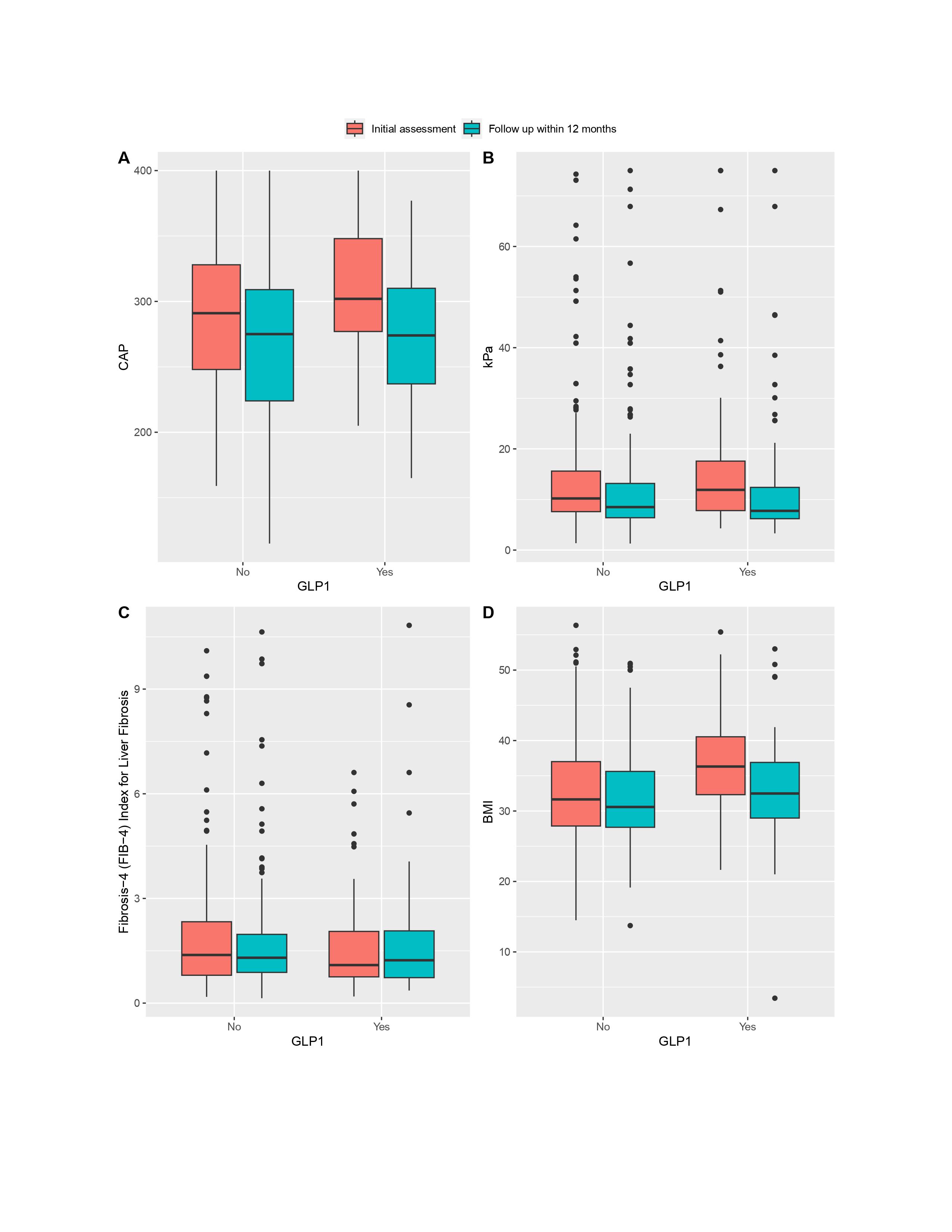Sunday Poster Session
Category: Liver
P1226 - The Efficacy of GLP-1 Agonists in the Management of MASH in an Appalachian Cohort
Sunday, October 27, 2024
3:30 PM - 7:00 PM ET
Location: Exhibit Hall E

Has Audio

Omar Almetwali, MD
Joan C. Edwards School of Medicine, Marshall University
Huntington, WV
Presenting Author(s)
Omar Almetwali, MD1, Abdelwahap Elghezewi, MBBCh2, Adolfo A. Torres, BS1, Mohammed El-Dallal, MD, MMSc1, Tejas Joshi, MD2
1Joan C. Edwards School of Medicine, Marshall University, Huntington, WV; 2Marshall University Joan C. Edwards School of Medicine, Huntington, WV
Introduction: Metabolic dysfunction associated with steatotic liver disease (MASH) encompasses several conditions such as obesity, Diabetes mellitus (DM), and hyperlipidemia (HLD). Glucagon-like peptide-1 (GLP1) agonists have entered the market for managing obesity and DM. Following their success, we investigated their role in ameliorating hepatic steatosis (CAP) and fibrosis (kPa) in a unique Appalachian cohort.
Methods: This retrospective study examined patients with MASH who had undergone > 2 liver elastographic studies while controlling for causes of primary liver disease, sociodemographics, comorbidities, and potential decompensated liver disease. The cohort was categorized into groups based on the usage of GLP1 medication. The comprehensive data collection included past medical history, medication, laboratory results, Fibrosis-4 Index for Liver Fibrosis (FIB-4), and BMI. The primary outcomes were changes in CAP, kPa, BMI, and FIB-4 index. To address the longitudinal aspect of data collection during patient follow-ups, a multilevel regression analysis was implemented for adjustment.
Results: Of the 276 patients in our cohort, 98 were on GLP1. Notably, they exhibited a higher prevalence of DM, HLD, marginally elevated CAP on the initial Fibroscan and a greater initial BMI. Conversely, the FIB-4 index was lower.
In the outcome analyses, despite a trend favoring GLP1 users in terms of improving CAP, statistical significance was not reached (MD -6.7, 95% CI -18.38 to 4.98, p=0.26) (Fig 1A). There was no significant difference in kPa change during the one-year follow-up Fibroscan (MD -1.39, 95% CI -3.44 to 0.65, p=0.18) or change in FIB-4 (MD 0.21, 95% CI -0.20 to 0.62, p=0.32) (Fig 1B & C). There was a statistically significant decrease in BMI within the GLP1 group (MD -2.45, 95% CI -1.48 to -3.41, p= < 0.001) (Fig 1D).
Discussion: Trends in imaging and lab findings depicted a promising albeit not statistically significant inclination towards attenuating the degree of liver fibrosis. Our analysis illustrated a borderline statistically significant drop in the FIB-4 index. CAP scores followed a similar trajectory for the GLP1 group but lacked statistical significance. These findings promote the use of GLP1 agonists in steatotic liver disease, but further studies with larger sample sizes and a more longitudinal approach are needed to warrant any benefit. As expected, the GLP1 cohort showed a significant decrease in BMI compared to the control cohort, which may contribute to improved metabolic health.

Note: The table for this abstract can be viewed in the ePoster Gallery section of the ACG 2024 ePoster Site or in The American Journal of Gastroenterology's abstract supplement issue, both of which will be available starting October 27, 2024.
Disclosures:
Omar Almetwali, MD1, Abdelwahap Elghezewi, MBBCh2, Adolfo A. Torres, BS1, Mohammed El-Dallal, MD, MMSc1, Tejas Joshi, MD2. P1226 - The Efficacy of GLP-1 Agonists in the Management of MASH in an Appalachian Cohort, ACG 2024 Annual Scientific Meeting Abstracts. Philadelphia, PA: American College of Gastroenterology.
1Joan C. Edwards School of Medicine, Marshall University, Huntington, WV; 2Marshall University Joan C. Edwards School of Medicine, Huntington, WV
Introduction: Metabolic dysfunction associated with steatotic liver disease (MASH) encompasses several conditions such as obesity, Diabetes mellitus (DM), and hyperlipidemia (HLD). Glucagon-like peptide-1 (GLP1) agonists have entered the market for managing obesity and DM. Following their success, we investigated their role in ameliorating hepatic steatosis (CAP) and fibrosis (kPa) in a unique Appalachian cohort.
Methods: This retrospective study examined patients with MASH who had undergone > 2 liver elastographic studies while controlling for causes of primary liver disease, sociodemographics, comorbidities, and potential decompensated liver disease. The cohort was categorized into groups based on the usage of GLP1 medication. The comprehensive data collection included past medical history, medication, laboratory results, Fibrosis-4 Index for Liver Fibrosis (FIB-4), and BMI. The primary outcomes were changes in CAP, kPa, BMI, and FIB-4 index. To address the longitudinal aspect of data collection during patient follow-ups, a multilevel regression analysis was implemented for adjustment.
Results: Of the 276 patients in our cohort, 98 were on GLP1. Notably, they exhibited a higher prevalence of DM, HLD, marginally elevated CAP on the initial Fibroscan and a greater initial BMI. Conversely, the FIB-4 index was lower.
In the outcome analyses, despite a trend favoring GLP1 users in terms of improving CAP, statistical significance was not reached (MD -6.7, 95% CI -18.38 to 4.98, p=0.26) (Fig 1A). There was no significant difference in kPa change during the one-year follow-up Fibroscan (MD -1.39, 95% CI -3.44 to 0.65, p=0.18) or change in FIB-4 (MD 0.21, 95% CI -0.20 to 0.62, p=0.32) (Fig 1B & C). There was a statistically significant decrease in BMI within the GLP1 group (MD -2.45, 95% CI -1.48 to -3.41, p= < 0.001) (Fig 1D).
Discussion: Trends in imaging and lab findings depicted a promising albeit not statistically significant inclination towards attenuating the degree of liver fibrosis. Our analysis illustrated a borderline statistically significant drop in the FIB-4 index. CAP scores followed a similar trajectory for the GLP1 group but lacked statistical significance. These findings promote the use of GLP1 agonists in steatotic liver disease, but further studies with larger sample sizes and a more longitudinal approach are needed to warrant any benefit. As expected, the GLP1 cohort showed a significant decrease in BMI compared to the control cohort, which may contribute to improved metabolic health.

Figure: Figure 1. Outcome analysis: Changes in CAP (A), kPa (B), FIB4 score (C), and BMI (D) between the initial visit and the follow-up within 12 months stratified by whether the patients were on GLP1.
Note: The table for this abstract can be viewed in the ePoster Gallery section of the ACG 2024 ePoster Site or in The American Journal of Gastroenterology's abstract supplement issue, both of which will be available starting October 27, 2024.
Disclosures:
Omar Almetwali indicated no relevant financial relationships.
Abdelwahap Elghezewi indicated no relevant financial relationships.
Adolfo Torres indicated no relevant financial relationships.
Mohammed El-Dallal indicated no relevant financial relationships.
Tejas Joshi: Cook – Consultant. Echosens – Consultant. Gilead – Key Opinion Leader.
Omar Almetwali, MD1, Abdelwahap Elghezewi, MBBCh2, Adolfo A. Torres, BS1, Mohammed El-Dallal, MD, MMSc1, Tejas Joshi, MD2. P1226 - The Efficacy of GLP-1 Agonists in the Management of MASH in an Appalachian Cohort, ACG 2024 Annual Scientific Meeting Abstracts. Philadelphia, PA: American College of Gastroenterology.
